ADSactly Tech News - The Technology of Future Underwater Mining May Shock and Amaze you!
ADSactly Tech News: The Technology of Future Underwater Mining May Shock and Amaze you!
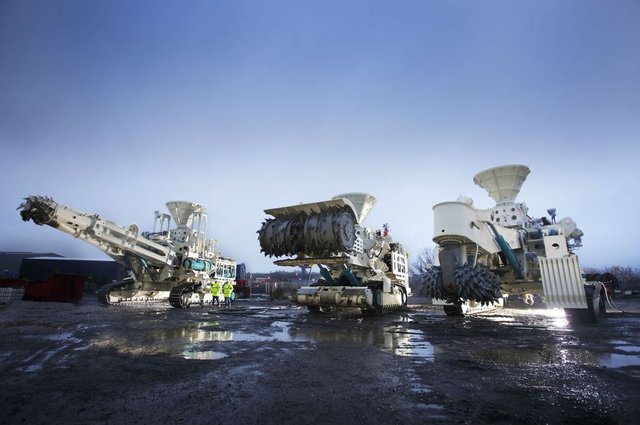
Image Source: Popular Mechanics
The technology of underwater mining is changing rapidly.
Engineers have developed an army of weirdly assorted monster machines that work seamlessly to bring up riches from the seabed.

Have you ever thought about the vast oceans that seperate continents and what might be going on out there in terms of technology? There are certainly fishing operations, oil platforms, cleanup operations in some cases (although much more is needed in terms of taking down plastic island...) but what many may not know is that mining operations are quite popular in our world's vast oceans and very few may know how they take place.
In this article I'd like to talk about how technology has transformed ocean mining operations and how these new operations may possibly affect our future. So without further introduction I'd like to tell you a true story about what's going on out there in the big blue sea.
Let your imagination take a trip with me. We are going to a remote location off the coast of Papua New Guinea. There we will find a 700-foot-long ship. Well I'm being modest when I just refer to it as a ship, in fact it is much more than that, it acts as a mobile command center, a control platform for an collection of mechanical monsters shown in the picture above.
This control platform is in charge of the logistics involving colossal robots that will be sent to bottom of the sea in search of treasure!
The colossal robots are headed for the Solwara 1 seabed. This is a place of interest due to its rich silver and copper deposits which have been found to be ten times the concentration that you'd find on land.
Here's a short description of what it is like down their in the deepest and darkest parts of this seabed:
seawater is superheated to around 750 degrees Fahrenheit by volcanic activity and jets from the sea bed. The hot water mixes with cold seawater and leaves behind tall rock chimneys rich in resources, deposits called seafloor massive sulfides (SMS).
As you can imagine it is very difficult to plan and manage such a large and complex operation such as the one I've asked you to imagine. It actually turns out that canadian company Nautilus Minerals has been at it for several years in preperation to begin excavating this difficult-to-reach place.
It is insane the level of precision is needed in engineering to pull off a mining job a mile under the sea. "Everything you do on land is ten times more difficult underwater," Mark Collins, Managing Director of ROV Systems at Soil Machine Dynamics stated.

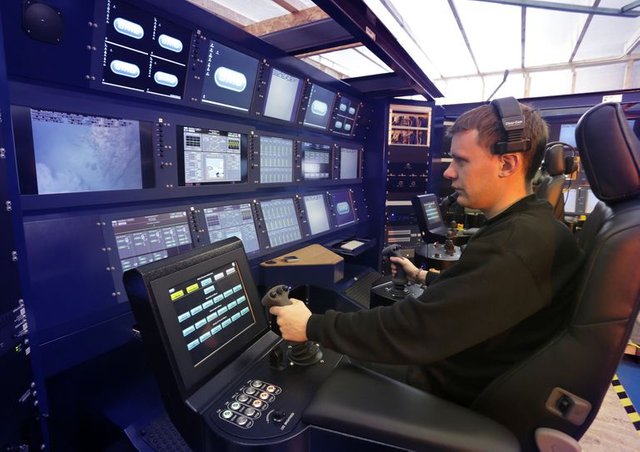
Image Source: Popular Mechanics

According to the research I've done about this I would definitely agree with the many experts who have said that the Solwara 1 is such a big task that to pull it off successfully they need an equally big machine. But it turns out that one machine simply isn't enough to get the job done, there are actuallyt three of them, and the smallest of them weighs more than two hundred tons!
The Production Support Vessel is a 700-foot mothership that controls not only the three giant drilling machines, but also the smaller scout bots that will go to the seabed first. The ship has an opening where cables and pipes snake down to the tank-like robots on the seafloor. Like other tracked vehicles, these megabots are steered by levers controlling the speed of each track. Each robot has a variety of sensors, including seven cameras, nine sonar heads pointing in different directions, gyros, accelerometers, and positioning sensors.
Can you imagine how complex the management of this operation actually is? This seems absolutely huge to me! Operators are in charge of these mega-machines as well as little scout bots and they are all operating together like some sort of odd underwater ballet!
Beyond the fact that the management is extremely complex due to the number of assets that drivers are required to operate simultaneously, to make matters even more difficult, operators are sometimes forced to drive blind! It doesn't always start that way considering the fact that the robots have powerful lights but it doesn't take long before visibility is completely destroyed because mining operations turn water cloudy faster than a cheetah could take down its prey.
But what can be done if they can't see where they are going? Fortunately they have prepared for this outcome and when the water gets too murky, operators can rely on 3D sonar and positioning sensors.
The technology involved is very high-tech as these machines are also built with other sensors that can assist in cutting and collecting. There are also instruments capable of showing vibration and pumping pressure. Of course they wouldn't be complete without underwater microphones called hydrophones, which allow operators to hear the sounds of the cutting head slicing through different types of rock. Does any of this sound absolutely amazing to you?


Now I'd like to discuss a few of the mega machines required to pull off a complex job like deep ocean mining.
After the scouts go in to survey and get a good look at the underwater real estate the first of three massive machines is ready to be put to work.
First up is the 250-ton auxiliary cutter. Built by British company Soil Machine Dynamics, the cutter’s design draws from tech used in underwater ploughs for cable laying and other seabed machinery. While this vehicles is certainly formidable, so are the obstacles it will face.
"You have a lot of underwater terrain features—cliffs, pockets, outcrops—that you can’t get around,” says Collins, Managing Director of ROV Systems at Soil Machine Dynamics. “It's like sending a tank down a rocky beach. It can fall down a hole, so you have to plan your moves carefully."
Apparently this is why the auxiliary cutter is so desperately needed. It carves out flat working surfaces called "benches" from the uneven seabed.
This auxiliary cutter has been nicknamed 'The Trailblazer' which seems to be quite a fitting title for it as its the first one in to begin the difficult process of underwater mining!

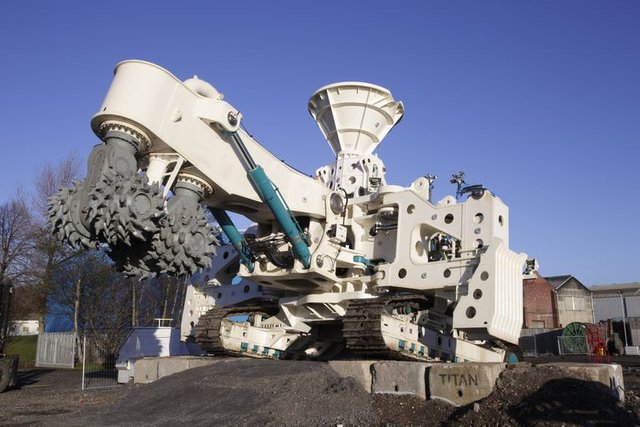
Image Source: Popular Mechanics
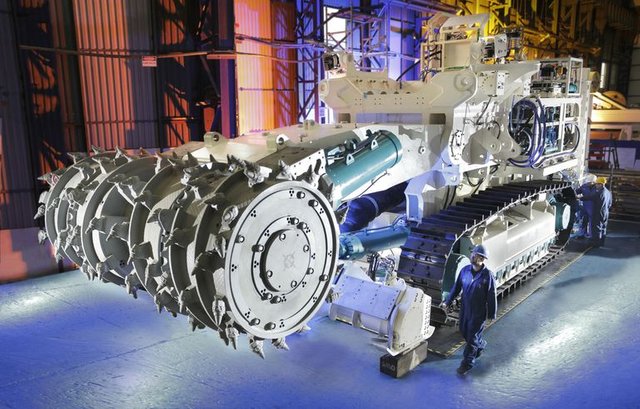
Image Source: Popular Mechanics
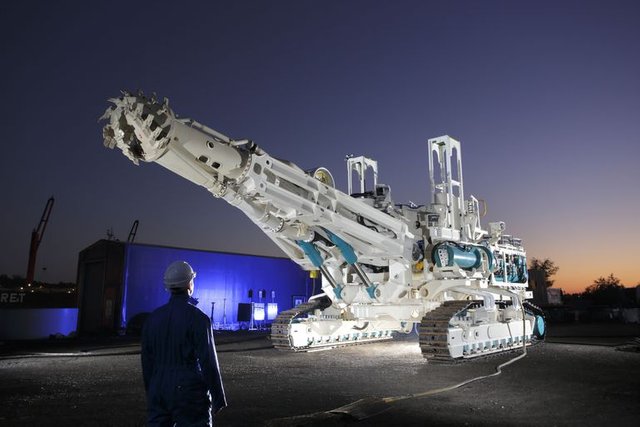
Image Source: Popular Mechanics

The second super machine is called the Big Beast! It is a bulk cutter. It weighs 310 tons and is also the largest of the three seafloor robots. Its electrically powered and connected to the surface with a long umbilical cable.
According to sources, its not as stable when compared to the auxiliary cutter. Due to this reason, it moves around carefully on the flat benches.
Getting a track caught on a protruding rock, or worse, toppling over, would be a disaster. While the top speed is only half-a-mile an hour, normal operations are carried at a much slower pace.
"It's like driving a bulldozer by remote control, with separate controls for the left and right tracks," says Stef Kapusniak, project director at SMD.
This machine is huge, heavy and requires an amazing operator that can even drive blind because the stakes are high when you work with the Big Beast!
Finally the last machine is a variation on a land based dredging machine. Its called the Super Sucker and it is basically a gigantic vacuum cleaner!
The operator uses this to agitate the piles of material left by the previous two robots, stirring it up with seawater so it can be sucked up in a slurry. This slurry passes through three 440-horsepower dredge pumps to the Subsea Slurry Lift Pump, and from there it is piped up to the surface.
Now that I've covered the story here I'd just like to add a few things that I haven't mentioned yet. Its interesting to know that on land an operation like this would involve countless trucks in constant movement. There would be a plume of dust and the whole environment would be extremely hazardous. But in a sea operation like this one very little happens above water... The ore is simply pumped on board.
Having done several environmental impact analyses with universities and environmental institutions, Nautilus says their mining operation will cause little disturbance compared to terrestrial mines. Using a commonly used measure of impact, the Nautilus project will cause around one-tenth as much disruption as an equivalent terrestrial mine.
I've got to say that I'm a bit cautious in saying an operation like this would be better than a land mining operation. I see both as very destructive to the world's ecosystems. I suppose if it needs to be done from a standpoint of visibility, at least we can't see the destruction and mutilation taking place because its all underwater but I wouldn't go so far as to say it is better than the alternative!
What do you think about the potential ecological problems that may result in relation to this operation? Do you think these machines are impressive? How do you feel about underwater mining vs traditional mining?
Here's a chance for the @ADSactly community to leave their thoughts and opinions on this topic!
Thanks for reading.
Authored by: @techblogger
In-text citations sources:
'Giant Robots Are the Future of Underwater Mining' - Popular Mechanics
Image Sources:
Popular Mechanics, Pexels

Click on the coin to join our Discord Chat

Witness proposal is here:
Go To Steem Witness Page
In the bottom of the page type: adsactly-witness and press vote.

Use small letters and no "@" sign. Or, click here to vote directly!
Thank you!

If that possible, then next project would be creating a community down there and live an ideal society. :)
wow they do look like beasts!
They are beasts. Man-made underwater digging and extraction machines...
New technology rapidly growth
For the Ocean floor to be mined in this way is like dredging a river. It completely destroys the ecosystem, cutting biomass and diversity of species for years creating a watery desert, possibly decades or more.
For this sort of expensive and dangerous procedure to be on the cards, then as with mining the Alberta oil sands, the earth is starting to run out of accessible resources.
To mine the ocean floor and risk further pollutions, this will cut the amount of fish that it can sustainably produce. I am appalled and further concerned that the one Green voice in Parliament may now be replaced by another anonymous Labour backbencher.
I agree with your points here and am truly concerned... Another good reason to make this as public as possible and get public opinion before its too late.
Wow very good technology
Good post friend @adsactly
I upvote and resteem
Hmmmmm so many AMAZING things happening on earth. Wow
Its pretty cool....
Is it Eco friendly? If it is Eco friendly then it is amazing technology.
a very good post, amazing technological advances can throw the world. please visit my blog.
Future Shocks: Rogue Technology - Nicholas Thompson - Deep Sea Mining Definitely Coming